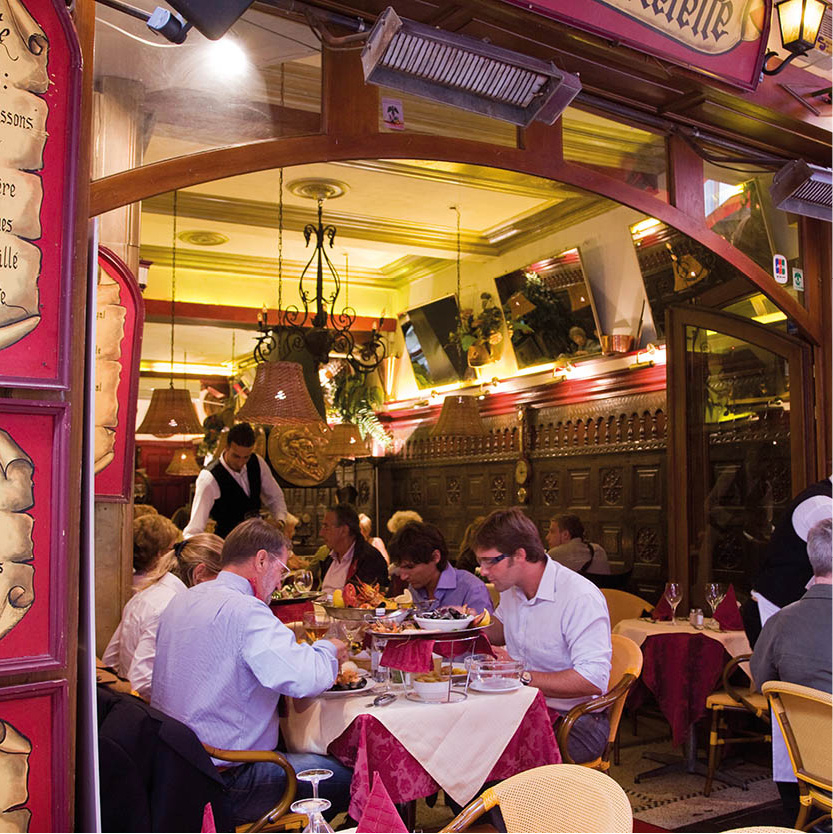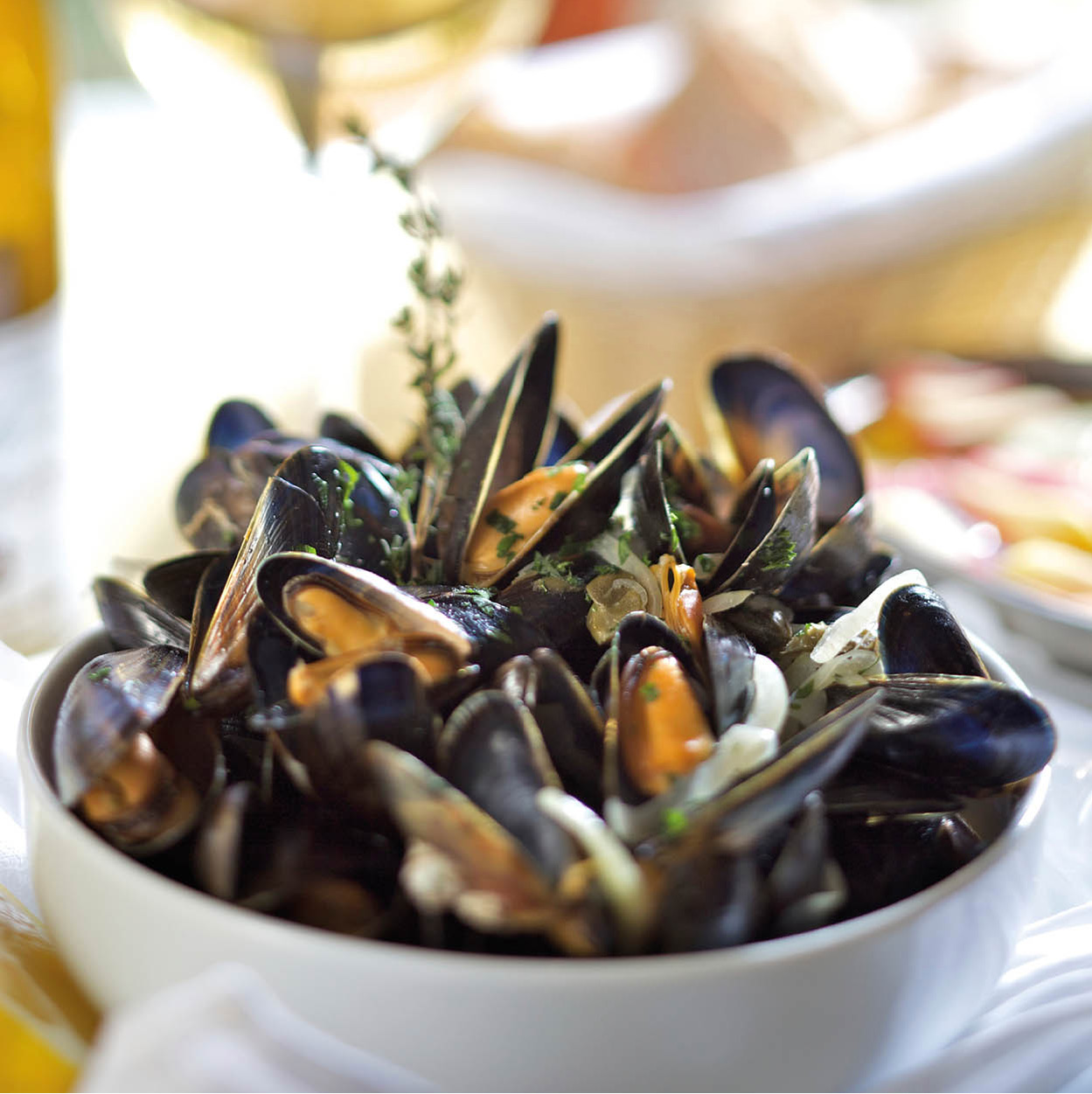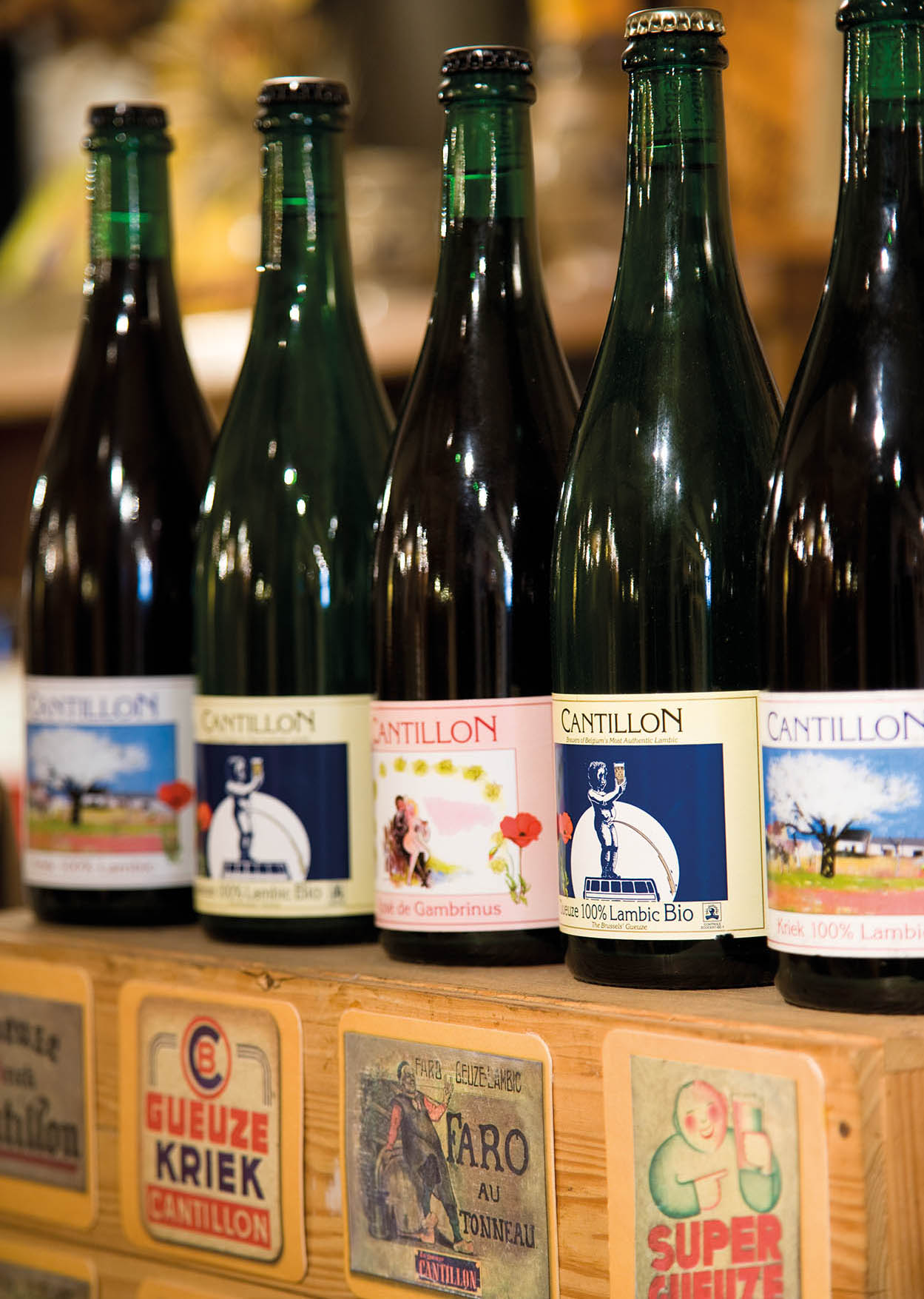Brussels has no shortage of fine restaurants, and its people enjoy eating out. Belgium does not have to look abroad for good food. It has a fine national and regional cuisine of its own, with hearty dishes based on fresh local ingredients. In addition, chefs have added personal twists to both their own dishes and the national dishes of their neighbours to produce unique creations. There are hundreds of eateries in the city, from formal to informal, with a range of prices, so you should find something to match your taste and budget.
As a cosmopolitan city, Brussels has some excellent international restaurants offering French, Chinese, Vietnamese, Greek, Moroccan and Japanese cuisine, among others. However, if you want to try Belgian cuisine, the information in this chapter will help you through the menu.
Some Brussels restaurants are happy to allow diners’ dogs into the dining room, and many let them on to outside terraces. Smoking is not allowed in restaurants, although it is still permitted in some cafés and snack-bars.
When to Eat
Eating in Brussels means fitting your appetite into set hours. Few restaurants stay open throughout the day. Lunch (déjeuner) is between noon and 2.30pm, while dinner (diner) is usually from 6pm until 10.30 or 11pm.
However, don’t worry that you won’t be able to eat at all in the afternoon in Brussels. There are numerous informal brasseries and cafés that serve food – though perhaps with a simpler menu – throughout the day. Look out for signs saying ‘nonstop’ outside an establishment, which simply means what it says.
What to Eat
There is a wide variety of speciality Belgian dishes, both Flemish and Walloon. Many local dishes are seasonal, so depending on what time of year you travel, you might not see all those mentioned below on the menu. The best restaurants serving Belgian food will change their menus several times each year to take seasonal offerings into account.
Among hors d’œuvres is a beer soup (soupe à la bière) with chicken stock and onions; a cold pâté of veal, pork and rabbit known as potjesvlees; flamiche, a savoury cheese pie with leeks or onions; tomate aux crevettes, tomato filled with shrimp and mayonnaise; and croquettes de crevette, small patties of shrimp. Fine smoked ham (jambon d’Ardenne) from the Ardennes region is also served.

A restaurant on rue des Bouchers
Julian Love/Apa Publications
Main Dishes
Belgium specialises in stews. The slow-cooked meat is always tender, the sauce tasty and the vegetables never overcooked. The only ‘difficulty’ lies in the portions, particularly at the smaller local brasseries, where they tend to be huge.
The best-known main dish is probably waterzooï, chicken (or sometimes fish) stewed with whites of leeks, potatoes, bouillon, cream and egg yolks. Anguille au vert is eel with green herbs, usually sorrel, sage and parsley. Carbonnades flamandes is a dish consisting of lean beef browned in a pan and then cooked in a casserole with lots of onions and beer. Pavé des brasseurs is a chateaubriand steak with beer sauce. Oxtail (queue de boeuf) is served in a savoury gueuze beer sauce. Hochepot, a pot-au-feu based on oxtail or pigs’ feet, ears and snouts, is another Flemish stew. Lapin à la flamande is rabbit marinated in beer and vinegar and braised in onions and prunes. High-quality game usually comes from the Ardennes region, and includes hare (lièvre), venison (chevreuil) and pheasant (faisan). If you like ham, try jamboneau, a shank of ham cooked with cream and served with potatoes and vegetables. Boudin rouge or noir is blood sausage, while boudin blanc is a lighter version of the same, enlivened by aromatic herbs; all are popular dishes, served with potato purée and an apple compôte.
Vegetables
Vegetable dishes include chou rouge à la flamande, red cabbage cooked with apples, onions, red wine and vinegar; and chicon (braised endives), often served gratiné au four (baked with cheese and ham). In April and May you may find hop flowers (jets de houblon) served with poached eggs and mousseline sauce. In spring try asperges de Malines, white asparagus with melted butter and crumbled hard-boiled egg, and choux de Bruxelles (Brussels sprouts), often with chestnuts and pieces of bacon, and cooked in goose fat.
Seafood
Even the east of Belgium is only a couple of hours from the sea, so seafood plays a prominent role in the national cuisine. Many Belgian towns have a fish market that has been in operation for hundreds of years, and Brussels has long been a big market for retailers and restaurateurs.

Mussels are a Belgian speciality
iStock
Moules (mussels) are probably the most famous Belgian dish. Harvested mostly from nearby Zeeland province in the Netherlands, they are delivered fresh to the capital each morning. Served steaming in a huge bowl, they come with a variety of sauces – marinières (white wine and cream), moutarde (mustard) and more besides.
One option to try is an assortment of fresh seafood, known as an assiette de fruits de mer (seafood platter). These dishes may include anything from mussels (moules) and spiny lobster (langoustines) to oysters (huîtres), crabs (crabes), whelks (boulots), shrimps (crevettes) and sea urchins (oursins). Along rue des Bouchers you can watch your plate take shape as a selection is chosen from the display of seafood on ice nearby. Or you could try a fillet or whole fish, delicately cooked to preserve its freshness. Try salmon (saumon), sole (sole), bream (daurade), mullet (rouget) or sea bass (loup de mer).
Desserts
Most restaurants offer cheese as a dessert option. Among as many as 300 different locally produced cheeses are the very strong remoudou, the djotte de Nivelles and cream cheeses from Brussels.
Crêpes (pancakes) are extremely popular and are served with a variety of accompaniments. Try them aux pommes (with apples) or à la grecque, with icing sugar and powdered spices. Or look out for the two-layered pancake with a tasty cheese filling, known as a double. Other desserts include beignets de Bruxelles (doughnuts or fritters), tarte au riz (rice tart), manons (chocolates filled with fresh cream) and speculoos (spicy gingerbread biscuits cut into shapes).
Chocolate gateaux take on a spectacular transformation from the ordinary to the divine at the hands of Belgian chocolatiers. Belgian chocolates and pralines are exported all over the world, but the best can still be found in Brussels.
Snacks
Waffles (gaufres) are the best-known dessert of Belgian origin and these are usually eaten in the street smothered with syrup, or at cafés with a generous helping of chocolate syrup or whipped cream.
If you’re looking for a savoury snack, then try the famous frites (French fries), available day and night at special stands (friteries, or, in Flemish, frietekotten) and usually served in paper cones with salt and mayonnaise. Caricoles (sea snails) are another street speciality. Eat them piping hot with the spicy broth in which they were cooked. You will also find a full range of sandwiches on offer. The most popular local bread for sandwiches is the pistolet, a large, crusty baguette.

The local brew
Julian Love/Apa Publications
Belgian Beer
Belgium is renowned worldwide for its beer. Historically, the cultivation of hops and barley was under the control of the many local monasteries. This resulted in high standards and differing flavours; indeed one particular type of beer, gueuze, can only be produced in a small region of the Senne Valley near Brussels because the micro-organisms that give the beer its distinct flavour are only found there.
Beer in Belgium is treated with the same degree of reverence as fine wine in France. There are numerous small breweries (though many are now owned by larger companies), producing small quantities of beer for the local market. Each is served in its own style of glass either from the bottle as you watch or from the tap, known as pression. Some have a high alcohol content. If you are unsure about which to choose, here is a short introduction to the range of beers you will find on your bar list.
Blanche. A cloudy blond beer made from wheat. Low in alcohol and very refreshing, it is a good option for a sightseeing break.
Brune. Darker beer.
Lambic. A beer that ferments spontaneously after exposure to the air. Now only produced by smaller independent breweries (a Belgian speciality). Very yeasty in flavour.
Gueuze. A lambic beer that has been fermented a second time.
Kriek. A lambic beer with the essence of fresh fruit that has been left to develop in huge vats. Cherry is the most popular.
Trappist. This is the strongest beer in Belgium. It is full-flavoured, dark in colour, with a distinctive smell of malt. Trappist beers date from the time of the monasteries and are enjoying a period of renewed popularity today.
Drinks
Coffee – hot, dark and strong – is the local drink of choice by day. If you want it with milk, ask for it au lait. Bars always serve coffee, tea and hot chocolate in addition to alcoholic drinks, a full range of international-brand spirits plus soft drinks or sodas. Try the locally made gin, which is known as pèkèt.
Most restaurants have a wine list – and some, particularly at the top end of the market, have very good cellars – and will offer you a good-value house wine in addition to more expensive bottles. Brasseries and smaller restaurants also offer house wine in half-litre and litre pichets or carafes. These are normally simple, but drinkable wines that pair well with the hearty meals on offer.